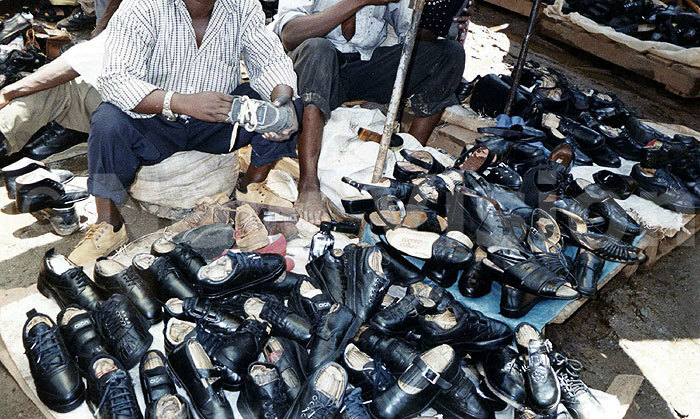Careful! A wrong shoe choice could harm your toes
"People who wear tight shoes that keep the feet moist are at a high risk of developing toenail fungus."
Then a Social Science student at Uganda Christian University (UCU), Ann Kimbugwe, did not know why the big toe on her right foot hurt.
She let it pass, until the pain got out of control, and she could barely place her toe down. Then she rushed to a clinic where it was found that she had pus in her toe, and had she delayed, she would have lost her toe.
"I can never forget the pain," Kimbugwe, now a social worker with the health ministry, says.
"But also, I think of how I kept insisting on wearing the same shoes thinking that after all I would take it off once I had reached my destination." She now regrets letting a love for those particular shoes let her bear the discomfort - until it became harmful.
Between 2005 and 2009, the American Academy of Orthopaedic Surgeons reported that American women's visits to the doctor for foot and toe complaints shot up by 75%.
Generally though, for every time one slips into a pair of shoes, experts say, one should first ask the question: ‘Are my feet breathing?' They say that the feet too need to breathe or else they become a breeding ground for a host of conditions.
"Wear the right shoes to the right place to avoid injury," Ronald Kyeyune, a physical therapist, starts.
"Go for the rounded front contrary to the pointed ones because these conform to the natural shape of the foot." He advises that one should ensure that the feet are relaxed, a thing to be achieved by avoiding tight or wide shoes.
"Women, yes, high heels make you look good, but they also increase pressure on the toes. If you must wear them, keep them on a minimal.
"When going for a run, ensure properly cushioned shoes that curtail foot injuries and direct pressure from the ground," advises Kyeyune.
Beyond injuries, there are conditions that arise from being unkind to one's feet.
"People who wear tight shoes that keep the feet moist are at a high risk of developing toenail fungus," says Grace Kisakye, a beautician at Oasis Mall in Kampala.
The feet need to breathe even when in closed shoes. "Fungus love heat and moisture, which tight shoes provide. Sometimes people do not dry their feet well, which are then stuffed into tight shoes, which breeds fungi," she says.
Another condition that afflicts toes is ingrown nails.
Elizabeth Nassiyo, a nurse at St Mathew's Clinic in Ntinda Kampala, says: "An ingrown toenail develops when the side of the nail grows while digging into the skin. This often leads to pus, swelling or even loss of a toe, if not treated."
She adds that wearing tight shoes worsens the condition because they cause the toenail to dig deeper into the skin.

Tight shoes can also lead to the development of bunions. Dr John Ekure of Kumi Orthopaedic Centre, the only orthopaedic hospital in the country, located in Kumi district, explains that a bunion is the swelling of bone or tissue around the joint at the base of the big toe. Because of this, the big toe may turn in toward the second toe and cause swelling and pain.
"Wearing shoes especially that are pointed and narrow at the front could force the big toe to turn towards the others," he says.
Meanwhile, Nassiyo says having the tight shoes or even socks rub against a sensitive spot on one's foot will cause friction. "When this happens, the body reacts by creating a fluid-filled sac called a blister. The skin underneath the blister is tender. This makes the blisters painful to walk on," she says.
Although associated mostly with people with diabetes, hammer toes can be caused by wearing short shoes - those where one has to coil their toes in to fit.
"This is when the toes take on a claw-like appearance, mostly because of nerve problems in the foot that cause the toe to curl up instead of lying flat," says Dr Samuel Kironde of Mengo People's Clinic.
Because of constant coiling, he adds, too much pressure is put on the muscles and nerves, and this causes harm to the toe joints and tendons, forcing them to curl in. "So they do not grow shorter, but they just curl inwards, in what could start as a fold, to fit, and just stay that way."
Tight shoes also cause blistering of the toes according to Kisakye.
"Sometimes people come with blister scars so big and when we try to soak the feet and scrap off the scars to help the skin regrow, the now hardened scars do not budge," she says.
Dr Kironde then explains that sometimes individuals end up with scar-filled toes. The scars arise from the fact that the skin protects itself against repeated friction and pressure by building hard layers of skin cells at the site of the irritation.
"This will lead to skin cells forming bumps, called corns forming on top or between the toes," he explains.
Kironde says that while corns develop on top of the nails, calluses usually form on the sole, but they can also occur elsewhere on the feet, and are thick, yellowish and flat. "They might seem harmless, but if the tight shoes do not stop, they can become breeding grounds for bacteria," he says.
Since they are dead cells, this mixes up with the moisture in the shoe and just like in the toe fungus, it could lead to bacterial infections, adds Kironde.
"Usually, an infected toe is mostly itchy, painful, tender, swollen and painful. But also, the skin tears, and many times between the toes, there could be wounds and sometimes, there could be pus."